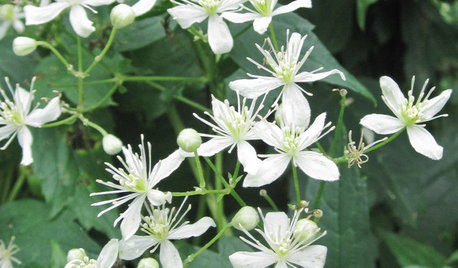Transplanting a clematis
rlaws
14 years ago
Related Stories

GARDENING GUIDESGreat Design Plant: Clematis Virginiana
Devil’s darning needles, a vigorous vine native to eastern North America, likes partial shade and many types of soils
Full Story
GARDENING GUIDES8 Plants for a Deliciously Fragrant Fall Garden
Scent the autumn air with the perfume of caramel corn, honey and spices by adding these intoxicating plants to your landscape
Full Story
INSPIRING GARDENSFrom Concrete Lot to Gracious Organic Garden in Seattle
Plants, pests and even weeds have a place in this landscape, which offers an edible bounty and a feast for the eyes
Full Story
SPRING GARDENINGTop 10 Scented Plants for Your Garden
A palette of perfumed plants can transform even the smallest of gardens into a sensory delight
Full Story
MOST POPULAR20 Ways to Work White Magic in Your Yard
Create enchanting outdoor spots with fresh white fences, florals and furniture
Full Story
WINTER GARDENINGPruning Secrets for Exquisite Roses
Encourage gorgeous blooms year after year with this time-tested advice on how to prune your rosebush in winter for health and shape
Full Story
GARDENING GUIDESGarden-Friendly Native Alternatives to Overplanted Exotics
There are lots of gorgeous, wildlife-friendly native plants ready to make an appearance in your garden
Full Story
EXTERIORSCare and Training for a Vine-Covered Home
Love the look but don’t want the ruin? Learn how to have vine-draped walls without all the cracks and crumbling
Full Story
GARDENING GUIDESHouzz Call: What’s Your Favorite Backyard Beauty?
The simple, honest daisy is this writer’s go-to garden flower. We want to hear which plant, flowering or otherwise, gives you special joy
Full Story
GARDENING GUIDES15 Native Flowers That Feed Native Bees
These perennials offer superfood to hundreds of bees and are gorgeous in their own right
Full StorySponsored
Franklin County's Full Service, Turn-Key Construction & Design Company
More Discussions







gardengal48 (PNW Z8/9)
flora_uk
Related Professionals
Arlington Landscape Architects & Landscape Designers · Ashland Landscape Architects & Landscape Designers · Forest City Landscape Architects & Landscape Designers · Finneytown Landscape Architects & Landscape Designers · Burlington Landscape Contractors · Cordele Landscape Contractors · Goodlettsville Landscape Contractors · Lake Saint Louis Landscape Contractors · Leicester Landscape Contractors · Live Oak Landscape Contractors · Mount Sinai Landscape Contractors · Pahrump Landscape Contractors · Santa Maria Landscape Contractors · Washington Landscape Contractors · Wheat Ridge Landscape ContractorsrlawsOriginal Author
flora_uk